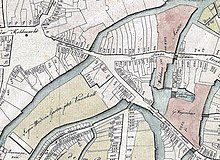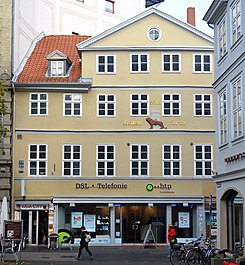Hat filters
| Hat filters | |
|---|---|
| Street in Braunschweig | |
| House Leuenturm , Hutfilter 2 | |
| Basic data | |
| place | Braunschweig |
| District | Downtown |
| Created | in the middle ages |
| Newly designed | after World War II |
| Hist. Names | u. a. in front of the korten brugge (until 1427), ante brevem pontem (1304), in the hotwelkeren (1427), in the hotfilter (1462), hatfilter (1606) |
| Connecting roads | Dam (to the east) |
| Cross streets | Kattreppeln (to the southeast) |
| Places | Kohlmarkt |
| Buildings | House Leuenturm , Katzenbalgen |
| use | |
| User groups | Foot traffic |
| Technical specifications | |
| Street length | 100 m |
Hutfiltern is a street in the city center of Braunschweig , at the transition from the historic Weichbild Altstadt to the Weichbild Altewiek . It is one of the oldest and was one of the most important trade routes in the city.
etymology
In medieval Braunschweig was Low German spoken. The craftsmen who lived in the street near the central Kohlmarkt were hat makers or hat felters , referred to in Low German as hôtfilter .
As with some other street names in the city of Braunschweig , for example Ölschlägern or Kattreppeln , the final "n" at the end of the word is, according to its origin, an old declination ending of the plural - dative and not used or understood since the 17th century has been used as a singular form ever since .
“This is because place names, when they appear in sentences, are in the vast majority of cases an answer to the explicit or implicit question" Where? " represent. And this question is answered in German with a preposition plus dative. So also in the case of in die hotfilter , loosely translated, by the hat makers' […] As far as this reinterpretation of the ending n is concerned, the Braunschweig street names Hutfilter and Ölschlägern (1405: by den olslegern, 'bei den Ölmüller' ) have parallel developed. "
history

The street runs roughly from west to east coming from Kohlmarkt and at its end merges into the Damm street, while at the same time it branches off to the southeast in the Kattreppeln. Originally the trade route , coming from the west from Minden and Hildesheim , continued to Magdeburg , 90 km to the east. The area of the old town or the Altewiek was swampy in the Middle Ages. A multitude of more or less large oker arms snaked through this area, which is why there were several bridges to cross them.
Over the centuries, the area around the hat filters was gradually drained, and in the late 19th century work began to channel the Oker underground in this urban area, or to fill in some of the smaller arms in order to gain building ground. The hat filter is now part of the inner-city pedestrian zone .
Buildings
In addition to numerous buildings that are now listed buildings, there are the following buildings:
- Hat filter 2: House Leuenturm , half-timbered house from 1777
- Hat filters 5 and 6: two half-timbered houses probably from the 19th century
- Hutfitlern 7: a solid building from 1904
- Hat filters 8: a solid building from 1887
Castle passage
For decades until 1981 the press house of the Braunschweiger Zeitung was located in the Hutfilter 8 building . In 1981 a breakthrough for the Burgpassage was created there , a covered 4-storey shopping arcade with originally 40 shops, up to the intersection of Schuhstrasse / Kleine Burg . The Burgpassage, which opened in 1983, was to be demolished in 2019 to make way for an open-top shopping and residential street. However, this project has been suspended since a court ruling at the end of 2019.
Cat bellows
A stele by the sculptor Siegfried Neuenhausen has stood at the junction in the Kattreppeln or at the transition from the hat filter to the dam . The title of the work refers to the popular, albeit false, assumption that the name Kattreppeln is etymologically derived from "wrestling cats" or "Katzbalgen".
literature
- Johannes Angel: hat filters. In: Luitgard Camerer , Manfred Garzmann , Wolf-Dieter Schuegraf (eds.): Braunschweiger Stadtlexikon . Joh. Heinr. Meyer Verlag, Braunschweig 1992, ISBN 3-926701-14-5 , p. 113 .
- Johannes Angel: hat filters. In: Manfred Garzmann , Wolf-Dieter Schuegraf (Hrsg.): Braunschweiger Stadtlexikon . Supplementary volume. Joh. Heinr. Meyer Verlag, Braunschweig 1996, ISBN 3-926701-30-7 , p. 71 .
- Herbert Blume : Braunschweig street names: hat filters, Kattreppeln and Abelnkarre. In: Braunschweigische Heimat , Volume 80, Braunschweig 1994, pp. 99–111.
- Jürgen Hodemacher : Braunschweig's streets, their names and their stories. Volume 1: Inner City. Cremlingen 1995, ISBN 3-92706-011-9 , pp. 160-161.
- Wolfgang Kimpflinger: Monument topography Federal Republic of Germany . Architectural monuments in Lower Saxony. Volume 1.1 .: City of Braunschweig. Part 1, pp. 97, 102-105.
- Heinrich Meier : The street names of the city of Braunschweig. In: Sources and research on Brunswick history. Volume 1, Zwissler, Wolfenbüttel 1904, p. 50 ( digitized version ), DNB 58068654X .
Web links
Individual evidence
- ^ A b Heinrich Meier: The street names of the city of Braunschweig. P. 50.
- ↑ Werner Spieß : History of the city of Braunschweig in the post-Middle Ages . From the end of the Middle Ages to the end of urban freedom 1491–1671. Volume 1, Waisenhaus-Buchdruckerei und Verlag, Braunschweig 1966, pp. 281–282.
- ↑ Herbert Blume: Braunschweig street names: hat filters, Kattreppeln and Abelnkarre. P. 100.
- ↑ Wolfgang Ernst: Braunschweig's underworld. Canals and vaults under the city. Volume 1: The Burgmühlengraben through the ages. Appelhans Verlag, Braunschweig 2011, ISBN 978-3-941737-40-2 , p. 38.
- ^ City of Braunschweig, Bauverwaltung (Ed.): Investigation into the building history of the Kohlmarkt. P. 28.
- ↑ a b c Wolfgang Kimpflinger: Monument topography Federal Republic of Germany. Architectural monuments in Lower Saxony. Volume 1.1 .: City of Braunschweig. Part 1, p. 102.
- ^ Norman-Mathias Pingel: Passages. In Luitgard Camerer , Manfred Garzmann , Wolf-Dieter Schuegraf (eds.): Braunschweiger Stadtlexikon . Joh. Heinr. Meyer Verlag, Braunschweig 1992, ISBN 3-926701-14-5 , p. 177 .
- ^ Braunschweig: demolition of the Burgpassage on modern-regional.de.
- ↑ [1]
- ↑ Herbert Blume: Braunschweig street names: hat filters, Kattreppeln and Abelnkarre. P. 106.
Coordinates: 52 ° 15 ′ 44.6 ″ N , 10 ° 31 ′ 16.1 ″ E


